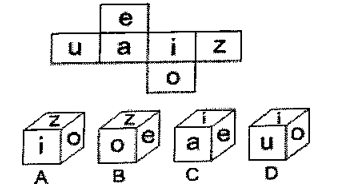Question 1:
Which option will come in place of question mark (?) in the given series?
दी गई श्रृंख्ला में कौन सा विकल्प प्रश्नवाचक चिन्ह (?) के स्थान पर आएगा?
4, 16, 13, ?, 49, 196
Question 2:
If 'A' denotes 'addition', 'B' denotes 'multiplication', 'C' denotes 'subtraction', and 'D' denotes 'division', then what will be the value of the following expression?
441 D 7 A 21 B 6 C (189 D 7) A (46 C 12)
यदि 'A' 'जोड़' को दर्शाता है, 'B' 'गुणा' को दर्शाता है, 'C' 'घटाव' को दर्शाता है, और 'D' 'विभाजन' को दर्शाता है, तो निम्नलिखित व्यंजक का मान क्या होगा?
441 D 7 A 21 B 6 C (189 D 7) A (46 C 12)
Question 3:
If the given sheet is folded to form a cube, then which of the following figures can be formed? (Letters are given only to indicate faces.)
यदि दी गई शीट को मोड़कर एक घन बनाया जाता है, तो दी गई आकृतियों में से कौन-सी आकृति बनना संभव है? (अक्षरों को केवल फलकों को इंगित करने के लिए दिया गया है।)

Question 4:
अक्षरों के उस संयोजन का चयन कीजिए जो दी गई श्रृंखला के रिक्त स्थानों में क्रमिक रूप से रखने श्रृंखला पूरी हो जायेगी
Select the combination of letters which when sequentially placed in the blank spaces of the given series will complete the series
I_ _ QZ_ _K_ _IJ _ QZ
Question 5:
गोपाल ने गोविन्द की ओर इशारा करते हुए कहा, “इसका पिता मेरे पिता का इकलौता पुत्र है " । गोविन्द से गोपाल का क्या संबंध है ?
Pointing to Gopal, Gopal said, "His father is the only son of my father". How is Gopal related to Govind?
Question 6:
निम्नलिखित में से किन परस्पर परिवर्तनीय चिह्नों से यहाँ दी गई समीकरण सही हो जाएगी?
Which of the following interchange of signs will make the equation given here correct?
(6 + 3) × (4 × 7) = 29
Question 7:
चार शब्द दिए गए हैं जिनमें से तीन किसी प्रकार से एक समान हैं और एक असंगत है। उस असंगत शब्द को चुनिए।
Four words are given out of which three are alike in some way and one is different. Choose the odd word out.
Question 8:
एक नदी दो कस्बों A और B को जोड़ती है। यह कस्बा A से दक्षिण की तरफ 37 मील की दूरी तक बहती है, फिर यह पश्चिम की तरफ मुड़ जाती है और आगे 23 मील तक बहती जाती है, फिर यह उत्तर की तरफ मुड़ जाती है और आगे 40 मील की दूरी तक बहती है, फिर यह अपने दाहिनी ओर मुड़ जाती है और 23 मील दूर स्थित शहर B तक पहुंचती है। शहर B के संबंध में शहर A कहाँ है?
Joins towns A and B. It flows south for 37 miles from town A, then it turns west and flows for 23 miles, then it turns north and flows for 40 miles, then It turns to its right and reaches town B, 23 miles away. Where is city A with respect to city B?
Question 9:
कथन : A. सभी बच्चे विद्यार्थी हैं।A. All children are students.
B. सभी विद्यार्थी खिलाड़ी हैं।All students are players.
निष्कर्ष : I. सभी खिलाड़ी विद्यार्थी हैं।All players are students..
II. सभी बच्चे खिलाड़ी हैं।All children are players
Question 10:
I, J, K, L और M पाँच दोस्त हैं। K की आय L की आय से ज्यादा है किंतु, M की आय से कम है। J की आय सबसे कम है। I की आय K की आय से कम है। किसकी आय सबसे अधिक है? I, J, K, L and M are five friends. K's income is more than L's income but less than M's income. J has the lowest income. The income of I is less than that of K. Who has the highest income?




